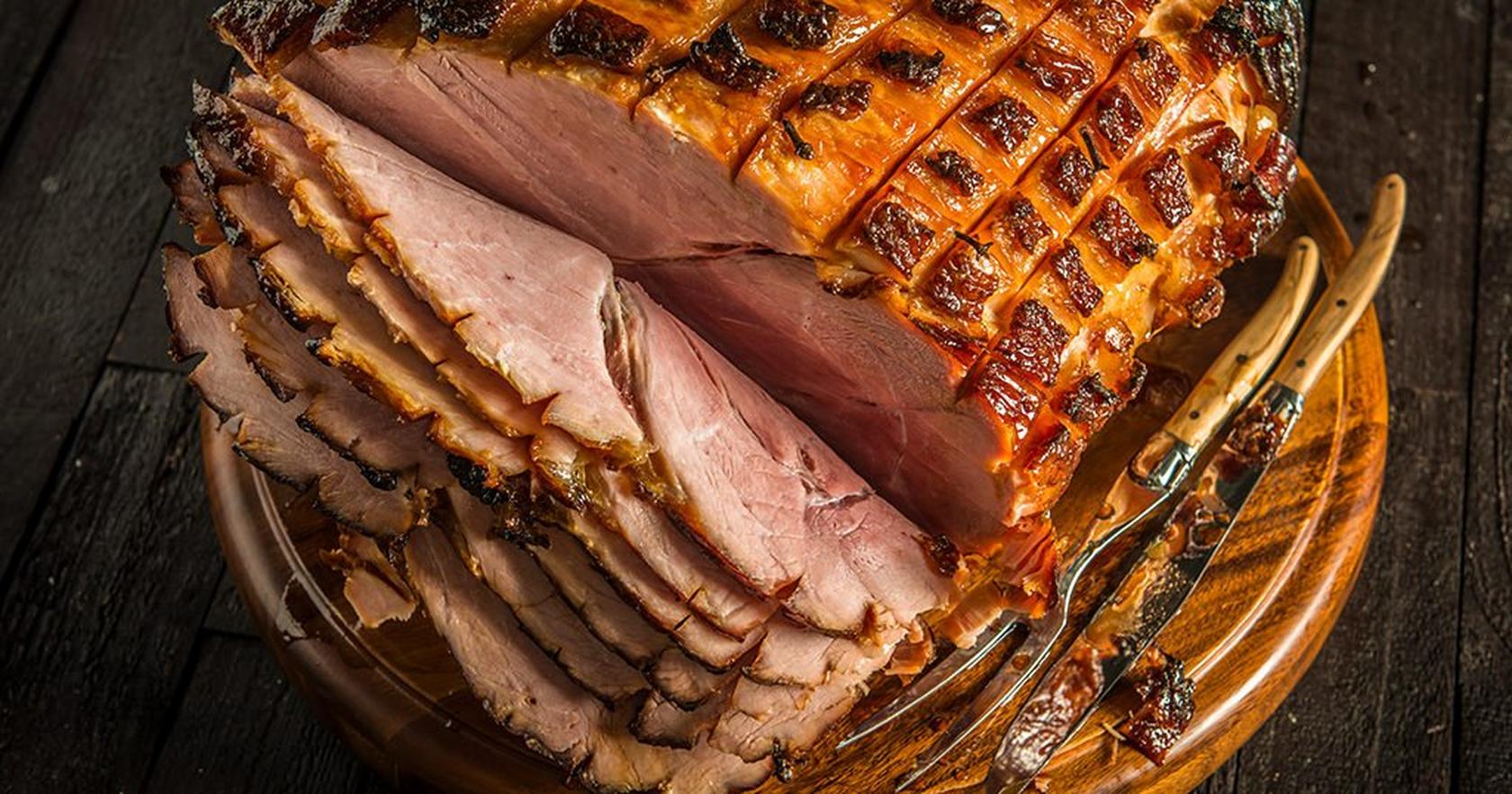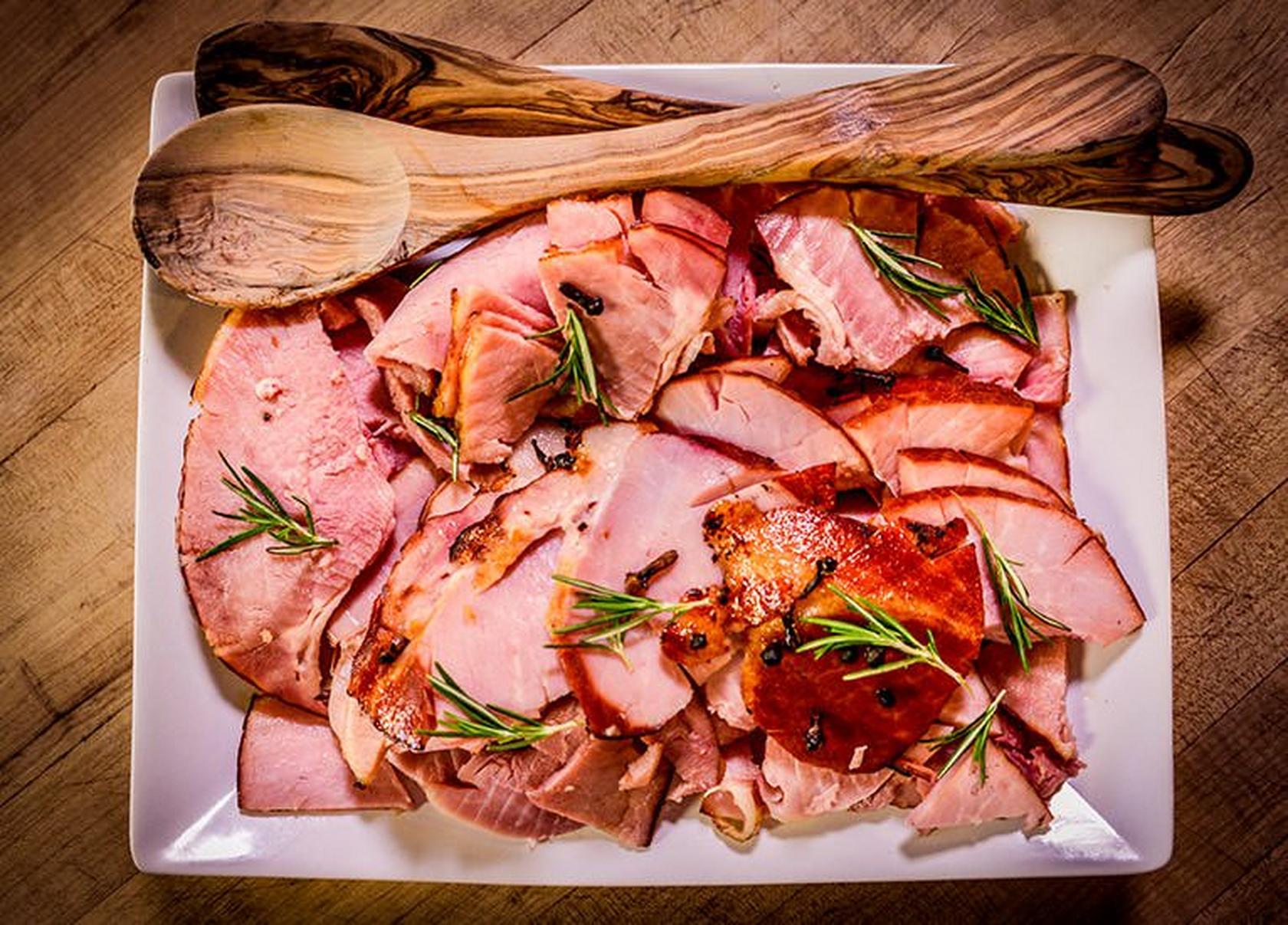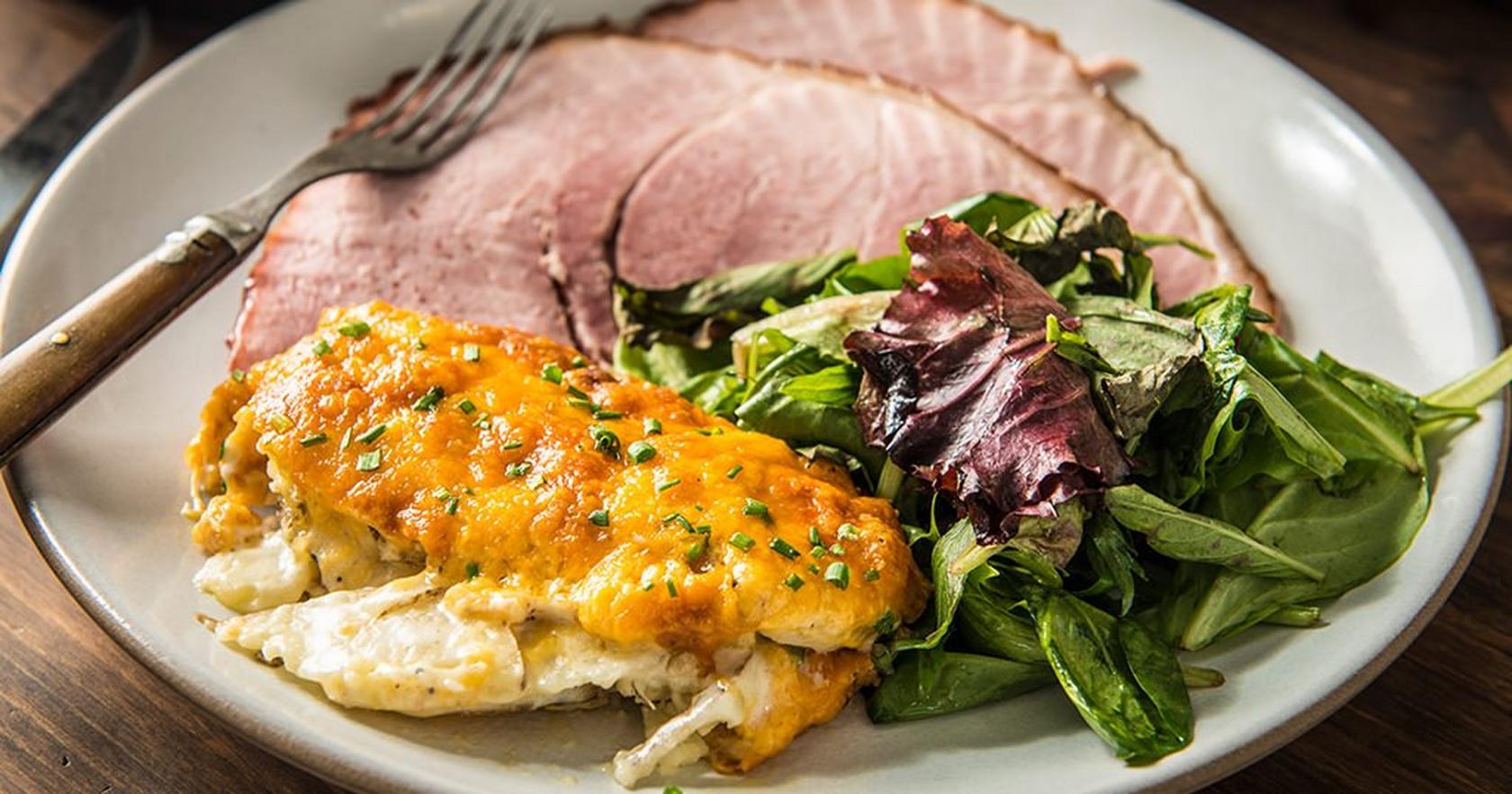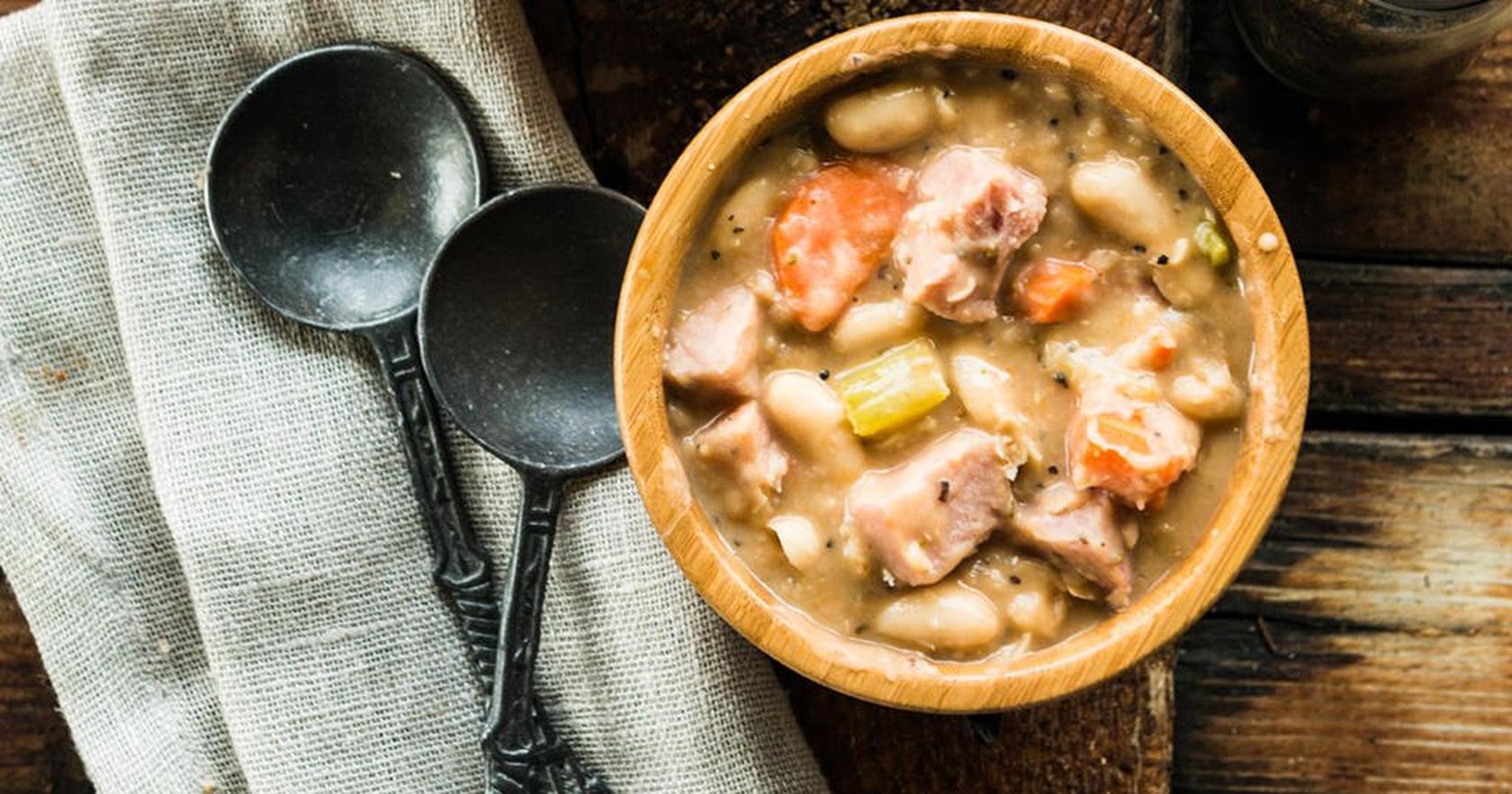
When there is ham on the menu, whether for a Sunday supper or a holiday celebration, what comes to mind is slices of tender, pink-hued, somewhat salty, somewhat smoky meat that pairs perfectly with a creamy potato gratin. Often coated in a sweet and deliciously sticky glaze, it’s an economical, and easy-to-cook star of a special meal.
Types of Ham
At its most basic, a ham is the hip and upper portion of the back leg of a pig. (The same name is used for other four-legged animals, but for our culinary purposes, we are sticking with pig.) Ham is not the front shoulder of the pig, which is sometimes—and confusingly—called a picnic ham.
The ham with which most of us are familiar is known as a city ham, and it’s what you will find in abundance at the supermarket, especially around the holidays such as Easter and Christmas. A city ham comes fully cooked having been wet cured and hot smoked and simply needs to be reheated for serving to yield tender juicy slices of savory meat (keep reading to see how to reheat your ham). Even, better, you can reheat such hams on your Traeger; for how to "double smoke" your ham, look here. Most city hams get finished with a glaze when reheated, adding a contrasting (and usually sweet) layer of flavor.
A country ham, by contrast, is a different kind of ham altogether and is not what usually graces the center of the holiday table as the main course. Popular in the American South, it’s intensely salty and usually enjoyed in smaller doses, often served with biscuits for breakfast.
A fresh ham—sometimes called a green ham (an old-fashioned term)—is the same cut as a city ham but uncured and raw. It’s the ham to buy if you want to cure and smoke your own ham start to finish, something that takes some time and expertise. A fresh ham is also delicious roasted.
For the purposes of this article, we are going to focus on the popular pre-cooked city ham and how best to choose it and cook it.
What Kind of Ham Should I Buy?
Even when you narrow the term ham down to mean a pre-cooked city ham, there are options to consider. Below we weigh the pros and cons of different choices.
Whole or half ham? What you find at the supermarket is generally a half ham which weighs in at 6 to 10 pounds. Even if you can find a whole ham, you may be better off cooking two half hams, which will heat more evenly without drying out.
Butt end or shank? When a whole ham is cut in half, there is the butt end (exactly what it sounds like and including the hip) and the shank end (cut further down the leg). The shank end has the classic ham shape, tapered at one end but can be a little chewy because the muscle gets a workout. It is the easier of the two to carve since it has only one long bone. The butt end tends to be more tender because it gets less of a workout than the leg, but it can be trickier to carve because it often contains the hip’s ball and socket as well as the aitch bone. For more on how to carve ham, keep reading.
Bone-in or boneless? A boneless ham is super easy to carve and can be very convenient but is often lacking in flavor and because it’s processed can have an off texture. (After the bones and much of the fat is removed, the meat is rolled into a sort of ham shape and wrapped in plastic.) This includes spiral hams, which, being pre-sliced, are even more convenient than regular boneless hams but more prone to drying out during cooking. A bone-in ham usually has more flavor, stays juicier, and offers the cook a prized possession: the ham bone. Simmered in a hearty soup like split pea or this white bean soup, a ham bone adds an incomparable savory, smoky flavor to the dish. A good compromise between flavor and ease of carving? Try a semi-boneless ham.
Added-liquid, or no? Hams that come injected with a savory liquid can be more juicy, but check the label to make sure you’re not also getting chemicals with that liquid. If that is the case, skip the added liquid.
What Size Ham to Buy
When buying a ham, consider at least a half pound of ham per person plus a couple pounds for leftovers. So, if you’re cooking for 10 people, look to buy a ham that’s at least 7 pounds. Keep in mind that leftover ham can be used in all kinds of ways: in soups, pasta, egg dishes, to flavor collards and other hearty greens, ham salad, and more. And sliced or diced ham can be frozen for months, too. Keep reading for specific ways to use up leftover ham including recipes.
How Long to Cook a Ham
While you can eat a city ham right out of the package, its flavor and texture benefit from being reheated (especially on a pellet grill). There’s no single right way to reheat a ham. You can do it with dry heat on the Traeger or in the oven or set it in a pan and add some flavorful liquid for a combination braise and bake that can keep it tender and juicy. (If you do use a liquid, baste the ham periodically with it to keep it juicy.) Some also like to wrap the ham in foil for the initial part of reheating to keep it moist. We recommend heating your ham up on the Traeger to give it additional wood-fired flavor.
What temperature should I cook my ham at and how do I know if it’s done?
In general, it’s best to reheat ham gently so as to not dry it out. Most Traeger recipes recommend setting the cook temperature to around 325°F. You can cook the ham directly on the Traeger’s grill grates for the most wood fired flavor or place it in a roasting pan with some liquid, such as apple cider, to keep the environment moist. If you want even more smoke flavor, you can cook it for longer at a lower temperature, such as 225°F and use Super Smoke if available.
The best way to tell if a ham is heated throughout is to check it with a meat thermometer. A leave-in thermometer, such as MEATER, is especially handy, as it tracks the temperature as the ham heats and displays it live. For best results, insert the thermometer deep into the ham, away from the bone, and cook the ham until the thermometer registers between 130°F and 140°F. The time this takes will vary depending on the size and cut of your ham, the grill or oven you are using, and, if applicable, the weather. Figure on 10 to 15 minutes per pound; this means 1½ to 2 hours for a 7- to 8-pound ham.

How to Glaze a Ham
Why, when, and how do I glaze my ham?
A glaze—a sauce brushed onto meats toward the end of cooking that caramelizes into a pleasantly sweet and sticky coating—is an easy way to dress up ham. A glaze gives the meat a luscious sheen while adding flavors that complement the sweet, salty meat. There are all kinds of glaze recipes out there. Almost all will contain some form of sugar sweetness—honey, maple syrup, or brown sugar—and many contain a splash of booze, such as the whiskey featured in this Roasted Ham with Bourbon BBQ Glaze. Aromatics, such as the cloves in this Baked Honey Glazed Ham, and fruit and fruit juices are other common glaze ingredients, such as the pineapple used to delicious effect in our Traeger Roasted Easter Ham.
Some hams come with a premade glaze to use on the ham, but they are often too sweet and most contain preservatives, so just chuck out that little packet of glaze. It’s easy to make a fresh glaze at home, but you can save a step and add loads of amazing flavor by using a Traeger glaze instead of homemade as in this Honey & Brown Sugar Glazed Ham. Keep it traditional with sweet Honey & Brown Sugar or add a layer of fruity heat with Mango Habanero.
When to Glaze a Ham
Because a glaze contains sugar, you want to find the right time to add it so that it cooks onto the ham and caramelizes but doesn’t burn. In general, you will want to brush a good coating of glaze all over the uncut sides of the ham when there is 20 to 30 minutes left to cook; if using a thermometer, you can glaze when the internal temperature gets to about 130°F.
Know that even though most hams have a glaze, it’s not required. You can also brush a ham with, say, a barbecue sauce toward the end of cooking or simply season it with one of our rubs and leave it at that.
For delicious ham recipes, most of which are glazed, look here.
How to Carve a Ham
Carving a boneless ham is easy. Simply place it cut side down and slice across the grain. For a spiral ham, cut off the slices by holding the knife horizontal. A bone-in ham is slightly more challenging (but worth it). No matter which you have cooked, it’s important to let it rest off the heat for about 20 to 30 minutes (longer for larger) before carving. This allows the juices to redistribute making for the most juicy bites. And for all hams, you will want three pieces of equipment for carving: a large cutting board, preferably with a trough to catch any juices, a carving fork , and a long, sharp knife.
How-to Carve a Butt Half Ham:
To start, place the ham cut side down on the board. With the carving fork, locate the aitch bone. Then carve alongside the bone to remove a large piece of boneless meat. Slice the boneless chunk thinly, between ¼ and ½ inch is good, then transfer the slices on a serving platter. To slice the bone-in section, flip the ham so the bone is now parallel to the board, then insert your fork horizontally next to the bone to hold the ham in place. Slice the ham downward until the knife hits the bone. Then turn your knife so it’s parallel to the board and cut along the bone to remove small slices. Hang on to the bone for using in soup and be sure to pick off bits of meat too small to slice to use in other dishes.
How-to Carve a Shank Half ham:
Find the bone using the knife and fork, cut off large chunks of the boneless sections, then slice those across the grain thinly.

What To Serve with Ham
With its mild, slightly sweet, smoky flavor, a ham goes with most sides. That said, it’s classically paired with potatoes, usually a creamy potato gratin, which balances the meat’s salty nature, or perhaps mashed potatoes made with loads of butter. Cooked greens, like these collards are another good choice. Grilled Asparagus & Honey-Glazed Carrots add gorgeous color and deep flavor. Macaroni and cheese, such as this ooey, gooey baked one, is also always welcome when ham is on the menu. And simple cooked peas are perfect for a pop of color.

What to do with Leftover Ham—the Meat and the Bone
As mentioned earlier, one of the best things about serving ham is the ham bone you’re left with afterward. Throw it in a pot of bean or split pea soup and you’ll be rewarded with deep, savory, and smoky flavors as in this White Bean & Ham Soup. A ham bone would also add flavor to long cooked vegetables such as kale or collards or even a long simmered sauce. But don’t feel you need to start cooking with it right away—after all, you likely just hosted a big dinner. The bone can be wrapped in plastic and refrigerated for a few days and can even be frozen for longer storage.
Ham meat, especially the smaller pieces not as well suited for the dinner platter, can be used in myriad dishes. (And don’t forget the bits of meat still on the bone. These small pieces works great in egg and pasta dishes.)
For breakfast, make these easy biscuits and serve them topped with an egg and warmed up ham or replace the pulled pork with leftover ham in this spicy eggs benedict. Use leftover ham in place of ham steak in a tasty frittata that would also work for lunch—and even dinner. You can also add small pieces of ham to your favorite mac and cheese for a boost of meaty flavor. Ham is also a welcome addition to just about any creamy side dish, including green beans, spinach, and potatoes. Also, feel free to swap in ham for bacon (they are cousins after all), especially when it’s used cooked and chopped as in this salad of grilled sugar snap peas.
—Joanne Smart is culinary editor at Traeger Grills.

Easter Ham
by Traeger Kitchen
38 Reviews
Prep Time
10 Min
Cook Time
1 Hr
30 Min
Serves
8
Pellets
Cherry
Celebrate Easter in style with a mouthwatering main that could not be easier to make. Simply reheat a smoked ham on the Traeger to give it additional wood-fired flavor and baste it with a simple but sensational glaze made with pineapple juice, brown sugar, and Traeger Sweet & Heat BBQ Sauce to make the perfect Easter ham.
Ingredients
main
| 1 | (6-7 lb) bone-in ham |
| 2 Cup | brown sugar |
| 1 Cup | Traeger Sweet & Heat BBQ Sauce |
| 1/2 Cup | pineapple juice |
1
Preheat the Traeger with the lid closed to 225°F; this will take about 15 minutes. For more smoke flavor, use [Super Smoke](https://www.traeger.com/learn/super-smoke), if available.
2
Insert a [leave-in thermometer](https://www.traeger.com/shop/meater) into the center of the [ham](https://www.traeger.com/recipes/ham), avoiding the bone. Place the ham cut-side down directly on the grill grates. Close the lid and cook for 90 minutes.
3
Meanwhile, in a medium bowl, mix together the brown sugar, Traeger Sweet & Heat BBQ Sauce, and pineapple juice.
4
Continue cooking, brushing the ham with the glaze every 10 or 15 minutes or, until the internal temperature of the ham is 140°F. The total cook time will vary depending on your ham your grill, and the temperature outside.
5
Remove the ham from grill. Slice and serve. Enjoy!